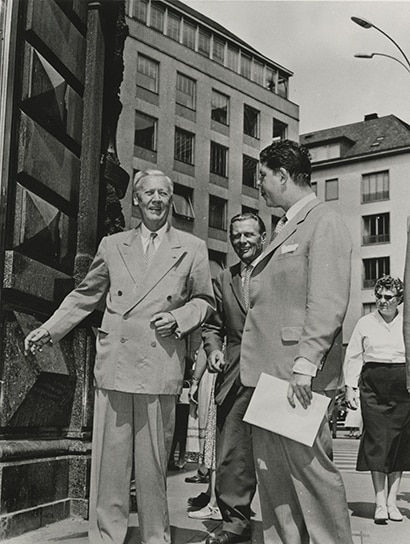Electrolux founder Axel Wenner-Gren looked into a Vienna shop window, saw a vacuum cleaner in and began to plan the future. However, his future bestseller Electrolux Model V was elegant, lightweight and easy to move around the home. Quite a contrast to the gigantic cleaners that had come before.

Axel Wenner-Gren revisits the sales office in Vienna where, in 1908, he saw a vacuum cleaner for the first time
Father of the vacuum cleaner
In 1901 British inventor, H.C. Booth, attended a demonstration of an American cleaning machine that blew dirt away and realised how much more efficient it would be if it could suck up the dirt. Very soon he lodged the patent for his own invention which did just that. It was large and bulky and became known as the Puffing Billy.
Soon the distinctive, bright-red, horse-drawn carriages of the British Vacuum Cleaner Company taking Booth’s machines to their next assignment became a familiar sight in London. Fame was ensured when he landed the job of cleaning dusty Westminster Abbey prior to Edward VII’s coronation. This led to a contract for the cleaning of Buckingham Palace, along with theatres, hotels, stately homes and factories. Booth had considerable entrepreneurial flair and an uncanny ability to find prestigious contracts. He sold cleaning services rather than the actual machines and was also the first to use the term vacuum cleaner.
Self-help was the mother of invention
In the United States things were developing in another direction. Janitor, salesman and part-time inventor, James M Spangler from Ohio, was asthmatic and suffered very badly from the dust at work. To improve his life quality, he invented a “suction sweeper” a portable vacuum cleaner. He realised that there could be a market for this device but lacked business acumen. Through his cousin, Susan, Spangler came into contact with her husband, leather goods manufacturer, William H Hoover.
Hoover saw the potential and in 1908 rapidly bought the patents, set up a production company, the Electric Suction Sweeper Company, and employed Spangler. Hoover’s name was to become synonymous with his products. Along with improving the prototype he also developed new sales techniques: door to door salesmen and the possibility of a trial period.
Seger produces the first Swedish vacuum cleaner
In Sweden a key figure in the development of the vacuum cleaner was Eberhard Seger, an engineer who was keen to develop a somewhat smaller machine which could be used in the home. In 1910 he launched the Salus, a large bucket-shaped cleaner, which weighed 30 kilos. Seger had registered the Swedish patent for the American “Santo” and his machine was a copy of it.
The jigsaw pieces were coming together. The Salus was manufactured by Lux and Sven Carlstedt’s company, Elektromekaniska, who were later to play an important role in the Electrolux story. Interestingly, it was a Santo which Wenner-Gren saw in that Viennese shop window.

